A Not So Quick Word About Pests and Pesticides on 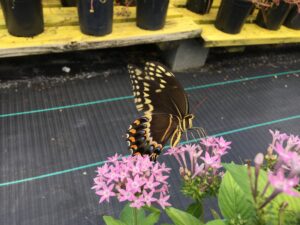 Butterfly Host and Nectar Plants
Butterfly Host and Nectar Plants
Many years ago, I was shopping for some lumber at a local big box store ( my local Ace in Greencove springs had stopped carrying lumber) anyway, being me, I stopped in the garden center on a sunny Sunday afternoon and looking around noticed just literally just hundreds of bees and wasps visiting the perennial plant sections neatly displayed across the tidy tables.
As I stood there watching them collecting their pollen and sipping theie nectar, I could not help but wonder how many would be left alive the next day. I knew those plants had been treated. Nothing I was looking at would survive the night. It overwhelmed me, at the time I was implementing what in the trade is called IPM strategies or Integrated Pest management, had begun only using organic pesticides like neem or 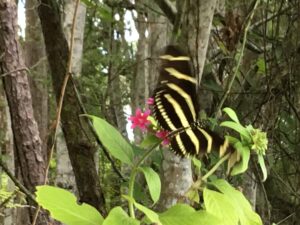 insecticidal soap that prevented the loss of beneficial insects on my flowers that I had previously grown with more harsh insecticides. I had already at that point started growing my own milkweed plants so that I knew they were safe but was also still buying in flowering perennial plants from those same vendors. I knew what they were treated with. but what could I do? I could not be sure that the flowers I bought in and did not grow myself were not doing the same thing?
insecticidal soap that prevented the loss of beneficial insects on my flowers that I had previously grown with more harsh insecticides. I had already at that point started growing my own milkweed plants so that I knew they were safe but was also still buying in flowering perennial plants from those same vendors. I knew what they were treated with. but what could I do? I could not be sure that the flowers I bought in and did not grow myself were not doing the same thing?
Did I do enough, know enough? Was I even asking the right questions? How long had it been since I had studied it? ( these are the questions that plague me when I try to sleep, knowing the impact that I have growing 40 acres of plants is a world of different than the average home gardener. )
 It was then that I decided to embark on a journey to continue to educate myself on how to save those pollinators and attempt to ensure that the growers I was buying from were not continuing to treat their flowers with pesticides that would harm the pollinators feeding on them. When I started to research there were a lot of new studies coming out on the harm they we may be doing. I quickly found out I would have to grow A LOT of things myself, and I have. Although I must say the tide is rapidly turning and there are a lot more conscious growers now than I had seen previously in the last 20 years in agriculture. I wasn’t the only one waking up!
It was then that I decided to embark on a journey to continue to educate myself on how to save those pollinators and attempt to ensure that the growers I was buying from were not continuing to treat their flowers with pesticides that would harm the pollinators feeding on them. When I started to research there were a lot of new studies coming out on the harm they we may be doing. I quickly found out I would have to grow A LOT of things myself, and I have. Although I must say the tide is rapidly turning and there are a lot more conscious growers now than I had seen previously in the last 20 years in agriculture. I wasn’t the only one waking up!
At times it has been a “bit of 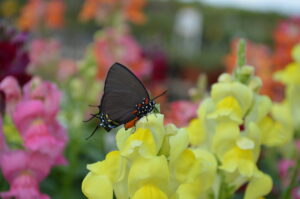 a journey” and at times it has been a “downright struggle” as some years are tougher than others. There are times it has been an all out joy, as a visit to the perennial section is alive with life during spring and summer. Sometimes beeming with activity to the point that it’s a bit overwhelming to a customer trying to purchase something and there are bees and other tiny little pollinating wasps all over it. Like the year I decided to grow a new Monarda called “Beebop”, they were not kidding! Bee bopping it was! The sheer number of pollianators on those plants was amazing, you could hear them before you were close enough to see them. They named the plant quite accurately and I ended up needing to relocate them away from the other flowers because they were literally scaring people away from the flower section!
a journey” and at times it has been a “downright struggle” as some years are tougher than others. There are times it has been an all out joy, as a visit to the perennial section is alive with life during spring and summer. Sometimes beeming with activity to the point that it’s a bit overwhelming to a customer trying to purchase something and there are bees and other tiny little pollinating wasps all over it. Like the year I decided to grow a new Monarda called “Beebop”, they were not kidding! Bee bopping it was! The sheer number of pollianators on those plants was amazing, you could hear them before you were close enough to see them. They named the plant quite accurately and I ended up needing to relocate them away from the other flowers because they were literally scaring people away from the flower section!
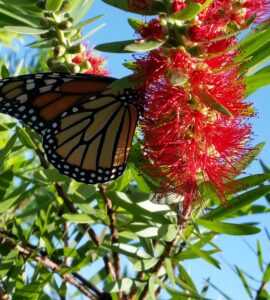 I hope you join me in the search for more pollinator and beneficial insect friendly plants and gardens at home, and I know that I will continue to get the occasional, ” I am not buying that “, ” that’s not a healthy one “, ” somethings been chewing on the leaves “, ” do you have one without these holes in the leaves “, I can’t win them all, but I will keep trying. A few chewed up leaves here and there will probably always make SOME people run for the hills, but I will still have a secret delight to myself as I see pollinators safely and happily feeding on the plants that I have set out and continue to imagine a bee chasing them back to their cars. 🙂 And hopefully, if there’s such a thing as Karma, all of the bugs that ARE plant pests I’m unable to live with that I end up squishing, stomping and cut in two with my scissors will be balanced out by all the pollinators that are happily buzzing about and all of the others that I leave to massacre one another. After all if a bug isn’t bugging a plant, its bugging another bug right? Its the circle of life. Nature can be quite vicious just read about those cute little lady beetles one day!
I hope you join me in the search for more pollinator and beneficial insect friendly plants and gardens at home, and I know that I will continue to get the occasional, ” I am not buying that “, ” that’s not a healthy one “, ” somethings been chewing on the leaves “, ” do you have one without these holes in the leaves “, I can’t win them all, but I will keep trying. A few chewed up leaves here and there will probably always make SOME people run for the hills, but I will still have a secret delight to myself as I see pollinators safely and happily feeding on the plants that I have set out and continue to imagine a bee chasing them back to their cars. 🙂 And hopefully, if there’s such a thing as Karma, all of the bugs that ARE plant pests I’m unable to live with that I end up squishing, stomping and cut in two with my scissors will be balanced out by all the pollinators that are happily buzzing about and all of the others that I leave to massacre one another. After all if a bug isn’t bugging a plant, its bugging another bug right? Its the circle of life. Nature can be quite vicious just read about those cute little lady beetles one day!
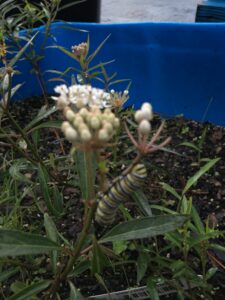 A Not So Brief Explanation of The Down Side of Pesticide Free Butterfly Plants
A Not So Brief Explanation of The Down Side of Pesticide Free Butterfly Plants
While not everything grown on our 18 acre site here at the S & J near Trout Creek Nursery site is pesticide free, I still use IPM ( Integrated Best management Practices) recommended by UFIFAS and the EPA. And will occasionally treat plants that are not directly being set aside for butterfly gardens with organic and beneficial insect safe methods. Our butterfly plants are grown here on site or grown from a select few growers I trust completely ( 2 at the moment in addition from myself) from seed and or cuttings and not treated with herbicides or ANY pesticides. None. Not even weed control ( I know it may be a bit extreme, but I treat them exactly like I do the edibles that people are going to eat, it was just the easiest thing for me to adapt to here on a large scale)
For this reason you may find some of natures little pests hanging around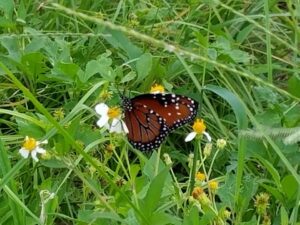 on your milkweed plant just like you would when growing them organically at home. If you spot a few aphids, rest assured that your plant is healthy and thriving and looking just as delicious to those aphids as it does to your Monarch butterflies.
on your milkweed plant just like you would when growing them organically at home. If you spot a few aphids, rest assured that your plant is healthy and thriving and looking just as delicious to those aphids as it does to your Monarch butterflies.
Plants that have been treated with topical and systemic pesticides will be free of other critters because those same critters munching away will die after feeding on the leaf and or nectar of the treated plants. That is something we do not want to do to the butterflies, bees and other pollinators that may stop by. That decision many years ago (actually done for the bees on my perennial plants that carried over into butterfly nectar plants and then to butterfy host plants) has caused me more grief than you could possibly imagine over the years, you would be surprised at how many 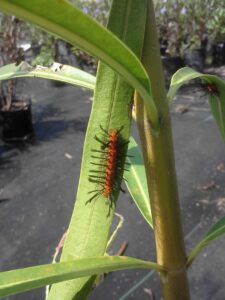 people don’t connect the two things in their mind. You can not simultaneously feed the butterflies and save the bees while growing a
people don’t connect the two things in their mind. You can not simultaneously feed the butterflies and save the bees while growing a
plant that nothing stopped by to make a meal out of at some point. Either your plant is part of the local ecosystem or it has been taken off the dinner table by the use of pesticides specifically targeted to kill those same insects we are trying to help survive. You just cant have it both ways.
So what is there to do? Regular scouting to hand remove and destroy pests! I like to use my daily watering time to inspect the undersides of the leaves looking for signs of damage or insect inhabitants. Keeping the plants well fed with natural things like compost tea and growing them in home made compost teeming with beneficial microorganisms helps to keep them strong and help them naturally overcome a bit of grazing here and there by chewing or sucking insects. Making sure they don’t stress from lack of water for prolonged periods also helps.
At home you can amend the soil with compost at the time of planting and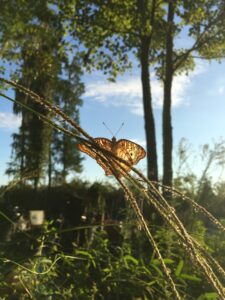 top dress your perennials with a shovel full of compost each spring, mulch with chopped up leaves or straw, pine bark etc. in the fall and check weekly for chewing or sucking insects that may be lurking about during the growing season. If you are one of those hands on gardeners that feels like you need to be doing something and can not leave well enough alone like I am, try making and using compost tea for a bi weekly foliar spray for your plants. An ounce of prevention is worth a pound of cure when it comes to
top dress your perennials with a shovel full of compost each spring, mulch with chopped up leaves or straw, pine bark etc. in the fall and check weekly for chewing or sucking insects that may be lurking about during the growing season. If you are one of those hands on gardeners that feels like you need to be doing something and can not leave well enough alone like I am, try making and using compost tea for a bi weekly foliar spray for your plants. An ounce of prevention is worth a pound of cure when it comes to
pest resistant plants. And last but not least, learn to live with a little bit of damage! Plants are remarkable things and have thrived on the planet without our help for a very very long time.
You won’t win every battle with bugs, but most of the time the plant comes out ahead in the end. I try to remind myself to “not be weary in well doing” For me, and most importantly, I will just continue to smile and explain to customers when necessary that the plant they are looking at is commonly used as a butterfly nectar plant or is currently being used as a butterfly host plant. Explain that the chewed on leaves are missing because the butterfly larva ate them, point out the beneficial insects already in place doing their job bugging those bugs because I didn’t kill them with chemicals, point out the big fat caterpillar culprit, tell them what kind of butterfly it will become once its done munching away and that there is nothing currently on the market to spray to treat those aphids that can not also affect the butterfly larva negatively or wash off the butterfly eggs etc.
Yep, it can at times get wearisome at times, but I always get to walk away hoping that someone at least for a brief moment had to stop and think that while we plant flowers for our own enjoyment, there is some thing else out there that likes them even more than we do. 🙂
Click the links below for more information on Pesticides and Pollinators
The problems with pesticides and pollinators:
http://monarchjointventure.org/threats/pesticides/
https://pesticidestewardship.org/pollinator-protection/pesticide-toxicity-to-bees/
How you can help:
https://pesticidestewardship.org/pollinator-protection/pesticide-applicator-bmps/

